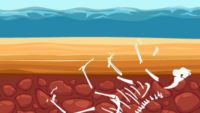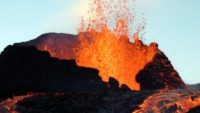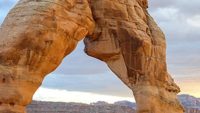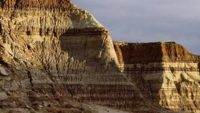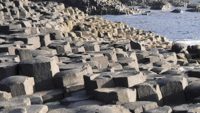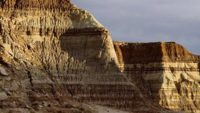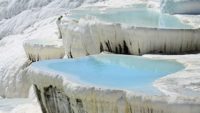By Ken Ham When you hear about fossils, it’s generally within the context of hundreds of thousands or millions of years. Indeed, a recent news article on lab-made fossils began with “fossils are certainly fascinating, but [they] do take rather a long time to form.” It later adds, “over the course of anywhere from tens of thousands to millions of years…the bones [turn] to stone.” But what did the lab-made fossils really demonstrate? They showed it doesn’t take millions of years to form fossils! Scientists were able to make fossils from fresh specimens in just 24 hours—one day! All it [More]
In the U.S. Gulf Coast region, the Upper Jurassic Norphlet Sandstone rests right on top of thousands of feet of Middle Jurassic salt, known as the Louann Salt. Secular geologists believe this sandstone layer was deposited by the windblown accumulation of sand in an arid environment. These kinds of deposits are commonly called aeolian deposits.1 Secular scientists never address or explain exactly how this cl… More… …read more Source: icr.org
By Avery Foley If there really was a global flood as described in Genesis, what would we expect to see today? Where are all the fossils of pre-flood humans? …read more Source: AIG Daily
By Dr. Andrew A. Snelling The visitor overlooks at Bryce Canyon, Utah, provide a breathtaking spectacle of row upon row of towering columns. …read more Source: AIG Daily
By Michael J. Oard Sometimes nature gives us a glimpse at the possibilities during the flood. Such a glimpse was provided by a recent ice storm on the mountains of Hawaii. …read more Source: AIG Daily
Catastrophic forces that carved flat vast swathes of the planet defy explanation in conventional geological thinking. …read more Source: <a href=http://creation.com/cypress-hills-planation-surface target=_blank title="Canadian landscape a testimony to the Flood” >creation.com
By Dr. Andrew A. Snelling The Devils Marbles are an iconic landmark in Australia’s Outback. …read more Source: AIG Daily
By Dr. Andrew A. Snelling Located just outside Moab, Utah, is a wonderland of more than 2,000 natural arches. …read more Source: AIG Daily
By Ken Ham Are we living in a new geologic age? Recently, geologists announced a name for the geologic age we live in: the Meghalayan Age. This new age is supposed to have begun 4,250 years ago. In the announcement, geologists also named two other ages, both older. This further divides up earth’s supposed 4.5 billion year history into various lengths of time. These geologists naming these ages are making a critical assumption. They’re assuming millions of years of earth’s history. This newest and most recent age, the Meghalayan Age, is based on oxygen isotopes found in stalagmites in an [More]
Deep time is more gap than rock record …read more Source: creation.com
Riding the rapids between walls of the Grand Canyon, a rafter supposedly peers up at millions of years. How do scientists arrive at such an old age? …read more Source: AIG Daily
By Dr. Andrew A. Snelling The Giant’s Causeway is Northern Ireland’s most iconic landmark. …read more Source: AIG Daily
For decades, creation scientists have debated the level at which the Flood ended in the rock record. In the past, many have based their conclusions on a cursory examination of the rocks, or concentrated only on the strata across the American West. Most agree that the Flood/post-Flood boundary is at one of two levels: 1) at the top of the Cretaceous system, known as the K-Pg (K-T) horizon,1,2 or 2) at or nea… More… …read more Source: icr.org
By Bill Worraker The Genesis Flood produced drastic geological changes involving extremely energetic processes which also generated an enormous heat load. …read more Source: AIG Daily
For many decades, creation scientists have included the Sixtymile Formation in Grand Canyon as part of the Sauk Megasequence that marks the onset of the global Flood.1 They based their conclusions on empirical data contained within the rock unit itself. And now, the secular geological community has arrived at a similar conclusion.2 Stopping short of admitting the possibility of a global Flood, Ka… More… …read more Source: icr.org
Secular scientists have a difficult time explaining an Ice Age, even though there is strong geological evidence that one occurred. In fact, creation scientists have long argued that the Genesis Flood is a vastly superior mechanism for explaining an Ice Age.1 Creation scientists have long argued that t… More… …read more Source: icr.org
Why calculations that undergird the uniformitarian explanation for ice ages are faulty. …read more Source: creation.com
How mineral-rich oceans hold clues to the age of the earth. …read more Source: creation.com
By Dr. Terry Mortenson Did the Flood really happen? Or is it a myth? Was it global? Or was it a local flood described in hyperbole? Was it a peaceful flood? And does it matter anyway? …read more Source: AIG Daily
A misleading museum display seems to want to exclude the truth of Genesis ‘by definition’. …read more Source: creation.com
Did the Surprise Canyon Formation in Grand Canyon have to form slowly by normal river erosion? …read more Source: creation.com
Climate change really heats up the headlines. Alarmists clamor that human activity and man-made pollutants are catastrophically disrupting Earth’s weather patterns. But is it all just a bunch of hot air? Well…mostly. True, over the last century Earth has gradually gotten warmer. But around 400 years ago it cooled with the Little Ice Age, and around 1,000 years ago it heated into the Medieval Warm Period. Climate change appears … More… …read more Source: icr.org
Concretions are remarkable geological curiosities. They are spherical carbonate formations composed of mineral cement. Concretions are found near and far, from Western Kazakhstan to beaches in California. Usually the size of cannonballs, they form from water eroding a piece out of sedimentary rock. They almost look man-made. Many fossils of dead creatures have been found inside these strange deposits. Several important questi… More… …read more Source: icr.org
Part 2: The geology and geography of Eden …read more Source: creation.com
By Dr. John Baumgardner This paper describes a numerical model for investigating the large-scale erosion, transport, and sedimentation processes associated with the Genesis Flood. …read more Source: AIG Daily
Many environmentalists are concerned with the anthropogenic production of carbon dioxide produced by burning fossil fuels. Research projects are being funded across the globe to find ways to sequester the “extra” CO2 produced by these processes in an effort to save our planet. These results show that … More… …read more Source: icr.org
By Dr. Andrew A. Snelling Every year “Cotton Castle” in Turkey attracts a million visitors. …read more Source: AIG Daily


















![Since Jesus Came Into My Heart [Live] Since Jesus Came Into My Heart [Live]](http://img.youtube.com/vi/eoCC1NjIHPE/0.jpg)




